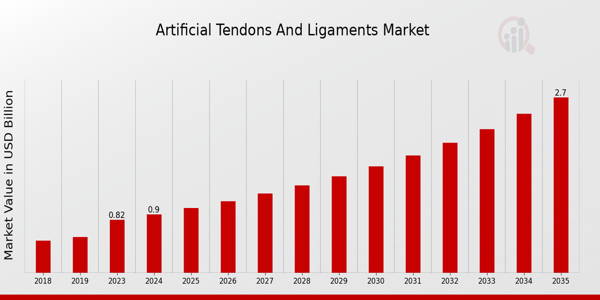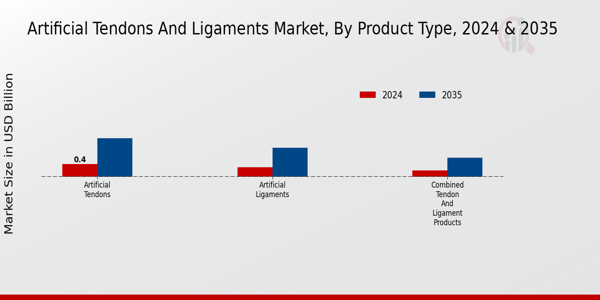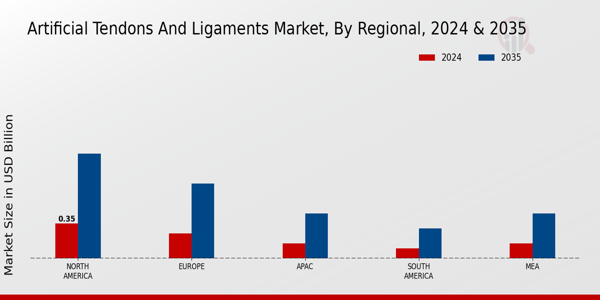Artificial Tendons and Ligaments Market Overview :
As per MRFR analysis, the Artificial Tendons and Ligaments Market Size was estimated at 0.82 (USD Billion) in 2023.The Artificial Tendons and Ligaments Market is expected to grow from 0.9(USD Billion) in 2024 to 2.7 (USD Billion) by 2035. The Artificial Tendons and Ligaments Market CAGR (growth rate) is expected to be around 10.46% during the forecast period (2025 - 2035).
Key Artificial Tendons and Ligaments Market Trends Highlighted
The Global Artificial Tendons and Ligaments Market is experiencing significant growth driven by increasing demand for advanced surgical procedures, the rising prevalence of sports-related injuries, and an aging population more prone to musculoskeletal disorders. Technological advancements in biomaterials, such as the development of synthetic polymers that mimic natural tendon and ligament properties, are also pushing the market forward. These innovations enhance the performance and integration of artificial implants in the body, making them a preferred choice for both patients and healthcare providers alike. There are ample opportunities to be explored, particularly in the areas of research and development, to create better-performing materials and designs.
Joint efforts between universities and industries can improve regenerative medicine. Newer markets are also ready to develop because of the increased healthcare spending and a heightened understanding of surgical alternatives. In addition, the opportunity for customized medicine, where treatment is provided based on specific requirements, is on the rise in this domain. Recently, there has been an increase in the number of people undergoing minimally invasive surgeries because of its advantages, such as faster recovery and lesser hospital admission periods. Moreover, 3D printing technologies are also advancing, which will result in ease of production of patient-specific grafts.
The focus is also shifting toward bioactive materials that not only support structural repair but may also promote healing and integration with surrounding tissues. Prioritizing patient outcomes and improving the quality of life through enhanced product performance remains at the forefront of market developments. Overall, the landscape of this market is continuously evolving, reflecting innovations in technology and increasing patient-centric approaches.

Source: Primary Research, Secondary Research, MRFR Database and Analyst Review
Artificial Tendons and Ligaments Market Drivers
Increasing Demand for Advanced Treatment Options
The Global Artificial Tendons and Ligaments Market is experiencing significant growth due to the rising demand for advanced treatment options for musculoskeletal injuries and degenerative diseases. As healthcare technology continues to evolve, patients are increasingly seeking innovative solutions that provide better outcomes, including faster recovery times and enhanced functionality.
This demand is driven by a greater awareness of the benefits of artificial tendons and ligaments, which offer improved strength and durability compared to traditional methods. Furthermore, with an aging population that is more prone to injuries and conditions requiring surgical intervention, the market for artificial solutions is expanding.
Patients are often looking for alternatives to autografts and allografts due to concerns about donor site morbidity and the risk of disease transmission. The improvements in materials science and surgical techniques are also encouraging healthcare providers to adopt these advanced solutions more broadly.
Additionally, the rise of sports-related injuries and the pursuit of active lifestyles among younger populations are contributing to higher incidences of ligament and tendon repairs, which further bolsters the market.
As healthcare professionals become more familiar with the advantages of artificial solutions, the adoption rate is expected to accelerate, driving the overall growth of the Global Artificial Tendons and Ligaments Market.
Technological Advancements in Biomaterials
The Global Artificial Tendons and Ligaments Market is significantly propelled by technological advancements in biomaterials used for creating artificial tendons and ligaments. Ongoing research and development efforts are leading to the emergence of new materials that not only improve the functionality and integration of these artificial solutions with the human body but also enhance their longevity.
Innovations such as 3D printing and tissue engineering are being utilized to create tailored products that meet individual patient needs. As these technologies continue to mature, they are expected to provide more effective and safer options for patients, further fueling market growth.
Growing Investment in Sports Medicine
The increasing focus on sports medicine, driven by the rising participation in sports and recreational activities, is becoming a key market driver for the Global Artificial Tendons and Ligaments Market. Healthcare systems and organizations are recognizing the importance of treating sports injuries effectively and enabling athletes to return to their activities promptly.
This acknowledgment has resulted in greater investments in research and development within sports medicine, leading to an increased demand for artificial tendons and ligament solutions that can withstand the rigorous demands placed on them during athletic activities.
Artificial Tendons and Ligaments Market Segment Insights :
Artificial Tendons and Ligaments Market Product Type Insights
The Global Artificial Tendons and Ligaments Market showcased a well-structured market segmentation under the Product Type category, which included Artificial Tendons, Artificial Ligaments, and Combined Tendon and Ligament Products.
In 2024, the market for Artificial Tendons held a significant position with a valuation of 0.4 USD Billion and is projected to rise to 1.2 USD Billion by 2035, showcasing its importance within this market. This growth was driven by the increasing number of orthopedic surgeries and rising demand for innovative treatments for sports-related injuries, indicating that Artificial Tendons dominated the product spectrum.
Following closely was the Artificial Ligaments segment, valued at 0.3 USD Billion in 2024 and anticipated to reach 0.9 USD Billion by 2035, which also played a crucial role due to its application in procedures such as ligament reconstructions. This segment was significant as it catered to a rising need for reliable surgical solutions, facilitating recovery and improving quality of life for patients.
Meanwhile, Combined Tendon and Ligament Products, with a valuation of 0.2 USD Billion in 2024, were deemed to be of lesser market share but still hold importance as they address specific trauma scenarios where both tendons and ligaments require intervention. This reflected the niche requirement and specialized usage within surgical procedures that integrate both types of support.
Overall, the growth trends in these product categories mirrored the increasing advancement in medical technology, along with a heightened awareness of sports medicine, which were poised to further enhance the Global Artificial Tendons and Ligaments Market revenue and overall market growth in the coming years, ultimately contributing to comprehensive solutions for patients with tendon and ligament injuries.
The Global Artificial Tendons and Ligaments Market data highlighted these shifts, allowing stakeholders to understand the preferences driving each product type forward. Market statistics revealed that innovations in materials and designs of these products were crucial in meeting the evolving demands and improving the surgical outcomes for patients.

Source: Primary Research, Secondary Research, MRFR Database and Analyst Review
Artificial Tendons and Ligaments Market Material Insights
The market encompasses several key material types including Polymer-based, Biodegradable Materials, Metallic Components, and Natural Tissue-based. Polymer-based materials hold a strong position due to their flexibility and durability, making them favorable in surgical applications.
Biodegradable materials are also gaining traction as they offer the potential for reduced environmental impact and effective integration with natural tissue, appealing to a growing market trend. Meanwhile, Metallic Components are recognized for their strength and stability, which are crucial in load-bearing applications.
Natural Tissue-based materials are significant as they provide a biocompatible option that closely mimics native tissue, thus promoting better healing outcomes. The diverse array of materials propelling the Global Artificial Tendons and Ligaments Market revenue ensures extensive applications across various medical fields, highlighting the importance of innovation and advancement within this sector.
Overall, the growth drivers in this market stem from an increasing incidence of sports injuries, advancements in regenerative medicine, and the demand for effective surgical solutions.
Artificial Tendons and Ligaments Market Application Insights
The market shows promising dynamics, driven by the increasing prevalence of sports injuries, the aging population, and advancements in bioengineering technologies. The Application segment includes types such as Orthopedic Procedures, Sports Medicine, Reconstructive Surgeries, and Trauma Cases, each holding a critical role.
Orthopedic Procedures dominate the landscape due to the rising incidence of musculoskeletal disorders, while Sports Medicine has gained traction with more athletes seeking improved recovery solutions. Reconstructive Surgeries represent a significant part of the market, reflecting the growing need for complex surgical interventions.
Trauma Cases are also essential as they cover injuries arising from accidents, thereby creating substantial demand for artificial tendons and ligaments. The combination of these factors fosters a robust environment for market growth; however, challenges like regulatory hurdles and the high cost of advanced materials may influence market dynamics.
Overall, the Global Artificial Tendons and Ligaments Market data indicates a favorable trajectory influenced by emerging opportunities in various Applications.
Artificial Tendons and Ligaments Market End Use Insights
The Global Artificial Tendons and Ligaments Market continues to evolve, with a significant emphasis on the End Use segment.
Hospitals play a crucial role, being primary settings for complex procedures involving artificial tendons and ligaments, ensuring comprehensive patient care. Meanwhile, Ambulatory Surgical Centers are gaining prominence due to their ability to conduct procedures with reduced recovery times and costs, thus appealing to a broader patient demographic.
Orthopedic Clinics stand out as specialized facilities that cater specifically to musculoskeletal disorders, making them pivotal in the advancement of treatment options within the market. The acceleration of technological innovations and increasing sports-related injuries are driving demand across these sectors, while challenges such as regulatory hurdles and high costs may pose constraints.
Nonetheless, the overall Global Artificial Tendons and Ligaments Market data reflects a robust growth trajectory, indicating robust opportunities for major stakeholders in this space.
Artificial Tendons and Ligaments Market Regional Insights
The Global Artificial Tendons and Ligaments Market witnessed notable growth across various regions, with North America leading the way. In 2024, North America was valued at 0.35 USD Billion and is expected to grow significantly to 1.05 USD Billion by 2035, showing its dominant position in the market due to advanced healthcare infrastructure and increasing demand for orthopedic solutions.
Europe followed with a valuation of 0.25 USD Billion in 2024, projected to reach 0.75 USD Billion by 2035, reflecting significant investments in healthcare technology. The Asia-Pacific region, although starting at a value of 0.15 USD Billion in 2024, is anticipated to witness robust growth to 0.45 USD Billion by 2035, driven by rising awareness of sports injuries and enhanced healthcare access.
South America and the Middle East Africa regions had smaller market sizes, valued at 0.1 USD Billion and 0.15 USD Billion in 2024 respectively, but both are expected to grow to 0.3 USD Billion and 0.45 USD Billion by 2035, illustrating emerging opportunities despite their lower presence.
Overall, the Global Artificial Tendons and Ligaments Market segmentation showed diverse growth potential, driven by varying healthcare demands and technological advancements across regions.

Source: Primary Research, Secondary Research, MRFR Database and Analyst Review
Artificial Tendons and Ligaments Market Key Players and Competitive Insights :
The Global Artificial Tendons and Ligaments Market has witnessed significant dynamics shaped by various factors, including technological advancements, an increasing prevalence of sports injuries, and a growing aging population necessitating orthopedic treatments.
Competitive insights in this marketplace reveal a robust landscape characterized by crucial innovations, strategic collaborations, and ongoing research and development initiatives aimed at enhancing product quality and patient outcomes.
This market is populated by diverse players who are aggressively maneuvering to position themselves as leaders by leveraging unique designs and biocompatible materials that offer better integration with human tissue.
Furthermore, regulatory frameworks and reimbursement mechanisms play a vital role in guiding market strategies, with companies often engaged in clinical trials to demonstrate the efficacy and safety of their products.
Arthrex stands out in the Global Artificial Tendons and Ligaments Market due to its pioneering role in orthopedic innovation, emphasizing minimally invasive techniques that align with current medical trends. The company is recognized for its commitment to high-quality manufacturing and comprehensive product lines, which are essential for both surgical procedures and rehabilitation processes.
Arthrex's strengths lie in its advanced understanding of surgical needs, enabling the development of tailored solutions that directly address specific patient and practitioner requirements.
Furthermore, its extensive distribution network and strong brand recognition contribute to a competitive advantage, positioning Arthrex favorably within this niche market by fostering trust and loyalty among healthcare professionals.
NuVasive is another influential player within the Global Artificial Tendons and Ligaments Market, with a corporate philosophy that prioritizes innovation and efficacy in spinal surgical solutions. The company has gained a solid foothold by focusing on disruptive technology that enhances surgical outcomes and promotes faster recovery times for patients.
NuVasive's commitment to research and development results in products that not only meet current market demands but also anticipate future healthcare trends. Their robust intellectual property portfolio and strategic partnerships in the industry further bolster their market presence, allowing NuVasive to drive significant growth while competing effectively against other key players.
The company's reputation for reliability and quality is reinforced by ongoing education and training initiatives for surgeons, thereby ensuring optimal utilization of their products in clinical settings.
Key Companies in the Artificial Tendons and Ligaments Market Include:
- Arthrex
- NuVasive
- Johnson and Johnson
- MediKarma
- Orthofix
- GRAFT Polymer
- Integra LifeSciences
- Smith and Nephew
- DePuy Synthes
- Tissue Regenix
- Zimmer Biomet
- Stryker
- Aroa Biosurgery
- Medtronic
- Osiris Therapeutics
Artificial Tendons and Ligaments Market Developments
The Global Artificial Tendons and Ligaments Market has recently experienced notable developments, particularly with key players such as Arthrex, NuVasive, and Johnson Johnson, making strides in innovation and market presence. These companies are advancing technologies aimed at enhancing the integration and functionality of artificial grafts.
Additionally, MediKarma and Smith Nephew are reported to be expanding their product lines to cater to the increasing demand for minimally invasive surgical options. Market growth is officially supported by projections indicating an increase in market valuation as the prevalence of sports-related injuries and aging populations drive demand for orthopedic solutions.
Moreover, the landscape of mergers and acquisitions has seen activity, with companies like Orthofix and Integra LifeSciences exploring strategic partnerships to bolster their product offerings and market reach. Stryker and Zimmer Biomet are also noted for their collaborative ventures, showcasing the competitive dynamic in this market.
The innovation spurred by these mergers, combined with consumer demand for effective and biocompatible solutions, is shaping the future trajectory of the Global Artificial Tendons and Ligaments Market.
Artificial Tendons and Ligaments Market Segmentation Insights
Artificial Tendons and Ligaments Market Material Type Outlook
Artificial Tendons and Ligaments Market Application Outlook
- Orthopedics
- Sports Medicine
- Reconstructive Surgery
- Trauma Surgery
Artificial Tendons and Ligaments Market End Use Outlook
- Hospitals
- Ambulatory Surgical Centers
- Research Laboratories
- Sports Clinics
Artificial Tendons and Ligaments Market Distribution Channel Outlook
- Direct Sales
- Distributors
- Online Sales
Artificial Tendons and Ligaments Market Regional Outlook
- North America
- Europe
- South America
- Asia Pacific
- Middle East and Africa
Scope:
| Attribute/Metric Source: |
Details |
| MARKET SIZE 2023 |
0.82(USD Billion) |
| MARKET SIZE 2024 |
0.9(USD Billion) |
| MARKET SIZE 2035 |
2.7(USD Billion) |
| COMPOUND ANNUAL GROWTH RATE (CAGR) |
10.46% (2025 - 2035) |
| REPORT COVERAGE |
Revenue Forecast, Competitive Landscape, Growth Factors, and Trends |
| BASE YEAR |
2024 |
| MARKET FORECAST PERIOD |
2025 - 2035 |
| HISTORICAL DATA |
2019 - 2024 |
| MARKET FORECAST UNITS |
USD Billion |
| KEY COMPANIES PROFILED |
Arthrex, NuVasive, Johnson and Johnson, MediKarma, Orthofix, GRAFT Polymer, Integra LifeSciences, Smith and Nephew, DePuy Synthes, Tissue Regenix, Zimmer Biomet, Stryker, Aroa Biosurgery, Medtronic, Osiris Therapeutics |
| SEGMENTS COVERED |
Product Type, Material, Application, End Use, Regional |
| KEY MARKET OPPORTUNITIES |
Technological advancements in materials, Rising demand for sports medicine, Increasing geriatric population, Growth of minimally invasive surgeries, Expanding healthcare infrastructure in developing regions |
| KEY MARKET DYNAMICS |
Rising sports injuries prevalence, Technological advancements in materials, Growing geriatric population, Increasing awareness of synthetic options, Expanding healthcare expenditure |
| COUNTRIES COVERED |
North America, Europe, APAC, South America, MEA |
Frequently Asked Questions (FAQ) :
The Global Artificial Tendons and Ligaments Market is expected to be valued at 0.9 USD Billion in 2024.
The market is expected to grow at a CAGR of 10.46% from 2025 to 2035.
The market is projected to reach a value of 2.7 USD Billion by 2035.
North America is expected to have the largest market share, valued at 0.35 USD Billion in 2024.
Artificial Tendons are expected to be valued at 0.4 USD Billion in 2024 and 1.2 USD Billion in 2035.
Artificial Ligaments are projected to reach 0.3 USD Billion in 2024 and 0.9 USD Billion in 2035.
Combined Tendon and Ligament Products are expected to be valued at 0.2 USD Billion in 2024.
Major players in the market include Arthrex, NuVasive, and Johnson & Johnson.
The APAC region is expected to be valued at 0.15 USD Billion in 2024.
The market presents growth opportunities driven by advances in medical technology, albeit faced with challenges such as regulatory hurdles.

















